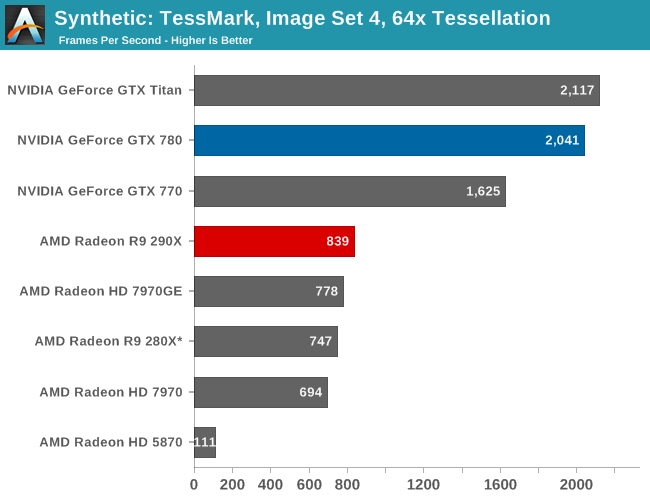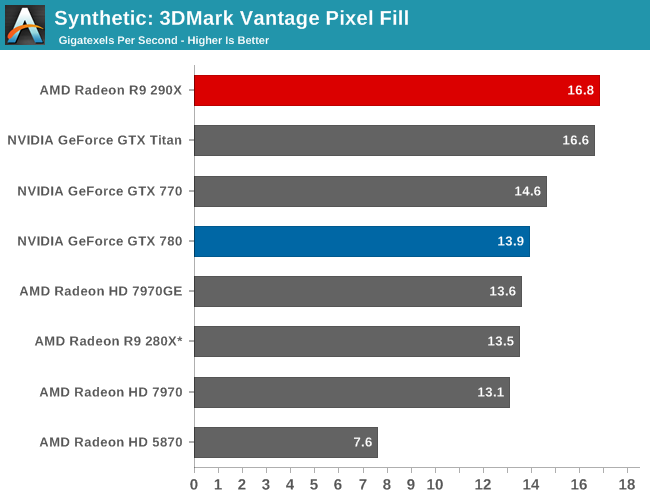The AMD Radeon R9 290X Review
by Ryan Smith on October 24, 2013 12:01 AM EST- Posted in
- GPUs
- AMD
- Radeon
- Hawaii
- Radeon 200
Synthetics
As always we’ll also take a quick look at synthetic performance. The 290X shouldn’t pack any great surprises here since it’s still GCN, and as such bound to the same general rules for efficiency, but we do have the additional geometry processors and additional ROPs to occupy our attention.

Right off the bat then, the TessMark results are something of a head scratcher. Whereas NVIDIA’s performance here has consistently scaled well with the number of SMXes, AMD’s seeing minimal scaling from those additional geometry processors on Hawaii/290X. Clearly Tessmark is striking another bottleneck on 290X beyond simple geometry throughput, though it’s not absolutely clear what that bottleneck is.
This is a tessellation-heavy benchmark as opposed to a simple massive geometry bencehmark, so we may be seeing a tessellation bottleneck rather than a geometry bottleneck, as tessellation requires its own set of heavy lifting to generate the necessary control points. The 12% performance gain is much closer to the 11% memory bandwidth gain than anything else, so it may be that the 280X and 290X are having to go off-chip to store tessellation data (we are after all using a rather extreme factor), in which case it’s a memory bandwidth bottleneck. Real world geometry performance will undoubtedly be better than this – thankfully for AMD this is the pathological tessellation case – but it does serve of a reminder of how much more tessellation performance NVIDIA is able to wring out of Kepler. Though the nearly 8x increase in tessellation performance since 5870 shows that AMD has at least gone a long way in 4 years, and considering the performance in our tessellation enabled games AMD doesn’t seem to be hurting for tessellation performance in the real world right now.
Moving on, we have our 3DMark Vantage texture and pixel fillrate tests, which present our cards with massive amounts of texturing and color blending work. These aren’t results we suggest comparing across different vendors, but they’re good for tracking improvements and changes within a single product family.

Looking first at texturing performance, we can see that texturing performance is essentially scaling 1:1 with what the theoretical numbers say it should. 36% better texturing performance over 280X is exactly in line with the increased number of texture units versus 280X, at the very least proving that 290X isn’t having any trouble feeding the increased number of texture units in this scenario.

Meanwhile for our pixel fill rates the results are a bit more in the middle, reflecting the fact that this test is a mix of ROP bottlenecking and memory bandwidth bottlenecking. Remember, AMD doubled the ROPs versus 280X, but only gave it 11% more memory bandwidth. As a result the ROPs’ ability to perform is going to depend in part on how well color compression works and what can be recycled in the L2 cache, as anything else means a trip to the VRAM and running into those lesser memory bandwidth gains. Though the 290X does get something of a secondary benefit here, which is that unlike the 280X it doesn’t have to go through a memory crossbar and any inefficiencies/overhead it may add, since the number of ROPs and memory controllers is perfectly aligned on Hawaii.










396 Comments
View All Comments
HisDivineOrder - Thursday, October 24, 2013 - link
It also beats it in highest temperature, which is ostensibly not the best thing to "win" at.Ryan Smith - Thursday, October 24, 2013 - link
As a heads up, a number of sections are still a work in progress. We got our second 290X much later than anticipated, so we worked on that so that we could bring you guys the Crossfire numbers and FCAT data right away.The rest of our writeup will be here by morning (we know you're all here for the charts anyhow).
Drumsticks - Thursday, October 24, 2013 - link
Thanks for the review! Pretty impressive to say the least.Before people (inevitably) whine about this being an "unfinished" review, I like how this is. It isn't exactly "polished" right now, but 90% of people are going to see the finished state. This also allows them to hit the review timing like AMD surely wants them to, while making sure the review is up to the standards we're used to.
banvetor - Thursday, October 24, 2013 - link
90% of Americans, you mean. Elsewhere in the world the day has already started for quite some time now...bill5 - Thursday, October 24, 2013 - link
kinda disapppointed with anand lately. you didn't even review most of the of the new amd lineup. and your bench suite is dated. Now we get a "work in progress" review?You're still in the upper echelon of sites with ease, but I think the site has slipped.
The Von Matrices - Thursday, October 24, 2013 - link
Couldn't you have just done a pipeline type review "First impressions" with the charts and then released a second article with analysis later? That would have made more sense to me than putting "work in progress."banvetor - Thursday, October 24, 2013 - link
I also strongly disagree with this strategy of publishing half-baked reviews (actually, in this case, seems more like quarter-baked or something) and only later filling it in.It would indeed make much more sense to publish a quick pipeline piece with some key graphs, and later (less than 24hs from Ryan's post above) publish the full review. If nothing else, it's more honest.
mfenn - Thursday, October 24, 2013 - link
Agree 100%. Situations like this are why the Pipeline exists. I don't come to Anandtech because you are the first. I come to Anandtech because you are the best. Take an extra few days to do a good, reference-quality review.superflex - Thursday, October 24, 2013 - link
Take an extra few days to do a good, reference-quality review which gives nVidia Titan the edge.There, fixed that for ya fanboy.
The butthurt is strong in this one.
pattycake0147 - Thursday, October 24, 2013 - link
I concur that this belongs in the pipeline. I waited to make a comment because of Ryan saying it would be finished in the morning, but morning is passed now and it is still a "work in progress". This is not what I have come to expect from Anandtech.